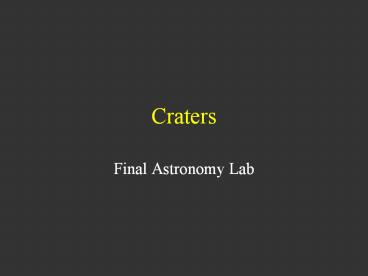Craters - PowerPoint PPT Presentation
Title:
Craters
Description:
If you have finished your collection, you may spend time with the resources ... Analyze Your Data. How about. this graph? Analyze Your Data. Or this one. Conclusions ... – PowerPoint PPT presentation
Number of Views:218
Avg rating:3.0/5.0
Title: Craters
1
Craters
- Final Astronomy Lab
2
Lunar Crater Categorization
- In 1978, Chuck Wood and Leif Andersson of the
Lunar Planetary Lab devised a system of
categorization of lunar impact craters. They used
a sampling of craters that were relatively
unmodified by subsequent impacts, then grouped
the results into five broad categories. These
successfully accounted for about 99 of all lunar
impact craters.
http//www.unm.edu/abqtom/images/Moon/Moon11-19-0
2b.jpg
3
The LPC Crater Types
- ALC small, cup-shaped craters with a diameter
of about 10 km or less, and no central floor. The
archetype for this category is 'Albategnius C'.
http//www.edwardroach.com/uploads/Albategnius_9-3
-07_504edt_300frames.jpg
4
The LPC Crater Types
- BIO similar to an ALC, but with small, flat
floors. Typical diameter is about 15 km. The
lunar crater archetype is Biot.
http//www.astrospider.com/images/moon/Biot_LAC98m
ap.jpg
5
The LPC Crater Types
- SOS the interior floor is wide and flat, with
no central peak. The inner walls are not
terraced. The diameter is normally in the range
of 15-25 km. The archetype is Sosigenes crater.
http//history.nasa.gov/ap15fj/photos/o/as15-97-13
288.jpg
6
The LPC Crater Types
- TRI these complex craters are large enough so
that their inner walls have slumped to the floor.
They can range in size from 15-50 km in diameter.
The archetype crater is Triesnecker.
http//www.damianpeach.com/lunartemp/triesnecker02
.jpg
7
The LPC Crater Types
- TYC these are larger than 50 km, with terraced
inner walls and relatively flat floors. They
frequently have large central peak formations.
Tycho crater is the archetype for this class.
http//upload.wikimedia.org/wikipedia/commons/7/7e
/Mooncrater.jpg
8
The LPC Crater Types
- Beyond a couple of hundred kilometers diameter,
the central peak of the TYC class disappear and
they are classed as basins.
http//www.uwsp.edu/geo/projects/geoweb/participan
ts/dutch/Sudbury/schrodinger.gif
9
Question
- How do the variables of velocity, size, and
meteor angle to surface affect the outcome of
resultant craters?
http//apod.nasa.gov/apod/image/0507/impact13sec_d
eepimpact_hri.jpg
10
Hypothesis
- Develop a hypothesis about the outcome of your
experiment based on your observations, reading,
and experience
http//www.photoaxe.com/wp-content/uploads/2007/02
/droplet.jpg
11
Your Lab
- You collected data on
- Speed of the impact (depending on height you
dropped your clay ball) - Angle of impact (depending on how far back you
were) - Size of meteor (depending on whether your clay
was 1, 2 or 3 pieces)
http//upload.wikimedia.org/wikipedia/en/c/c8/AS11
-42-6285.jpg
12
Finish Collecting Data
- Collect your data
- Return all your equipment
- If you have finished your collection, you may
spend time with the resources
http//crism.jhuapl.edu/education/downloads/GUIDE_
Lesson2.pdf
13
Analyze Your Data
- You collected 3 trials of a single variable, then
collected 3 trials of the next variable, and so
on. - Find the mean of each of your variables.
- Add three trials and then divide by 3
1.2 1.3 1.1 3.6 1.2
0.8 1.0 0.9 2.8 0.9 3.0
2.4 3.1 8.5 2.83
1.9 2.3 1.7 5.9 1.96
1.8 1.7 2.1 5.7 1.9 4.2
4.1 4.8 13.1 4.36
3.2 3.8 3.9 10.9 3.63
2.3 2.8 2.8 7.9 2.33 5.2
5.2 8.2 18.6 6.2
4.5 4.3 4.1 12.8 4.26
3.4 3.1 3.1 9.6 3.2 6.0
5.8 6.2 18.0 6.0
14
Analyze Your Data
- First, lets look at how our data varies around
the mean
15
Analyze Your Data
- Next, lets start picturing our data using
averages - Does this make sense?
16
Analyze Your Data
- How about this graph?
17
Analyze Your Data
- Or this one.
18
Conclusions
- What is your answer about the size, depth and ray
length as the velocity increases? - If you have any unusual data, give an education
guess what happened (most likely, human error)
19
For This Lab
- Produce an 8½ x 11 or larger poster of this
experiment - Introduction Background on craters (tell me how
they are formed) - List your citations
- Methods Describe your experimental design
(include your hypothesis) - Results Include both a table and graph of your
data - Discussion Tell me what you learned
20
Be Creative
21
Have Fun
22
What Did You Learn
23
Include 4 Sections































